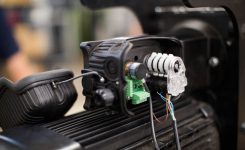Automation
IP Addresses
IP Addresses are extremely powerful (and necessary) communication tools for any computer system, including your home wifi, tablet, smart watch, phone and yes - even your automation system! For the most part, IP Addresses are doing their job in the background and we can move along with our day without a second thought as to how we can magically Google something, send an email or get the WTForecast.
Unfortunately there are other times when we need to actively focus on IP Addresses - generally this is right around the time tech is scheduled to begin or the curtain is to raise for 1st preview. Without a properly set IP Addresses, Spikemark and the Stagehand controllers will not communicate - it's almost like the Ethernet cable is unplugged!
UNDERSTANDING THE IP ADDRESS
Networks can be configured as DHCP Enabled or Static Addressed. No matter the configuration, the IP Address will always be comprised of four octets (segments) of up to 3 digits, separated by a period. Every Stagehand controller defaults to an IP address of 192.168.10.32 from the factory and can be adjusted in the field.
Most networks, (your phone, tablet, wifi), are set up as DHCP networks. DHCP stands for Dynamic Host Configuration Protocol. Breaking it down, this means the IP Address can change over time. This is fine for most devices, because there is a DHCP Server acting as the traffic cop confirming the correct info gets to the correct place. Spikemark and Stagehands require setting up unique, static IP Addresses for each device. This is to maintain communication between the devices without the need of a DHCP server.
Each unique IP Address tells Spikemark where to send specific commands for each device on the Network. Much like a postman delivering letters to homes with address numbers nailed to the mailbox, Spikemark sends its commands to Stagehands with unique address numbers. When setting up static IP Addresses there are only two tricks to keep in mind:
Each IP Address must be UNIQUEEach IP Address must have the first three octet's matching
Wait, how do you have matching AND unique values? SIMPLE! Using our default network parameters as an example, each device on the network will have an IP Address which begins with: 192.168.10.xxx. In this scenario "xxx" is replaced with any number between 1 and 254.
ORGANIZING YOUR IP ADDRESSES
As we know, each device on the automation network requires a unique static IP Address in order to communicate. These IP Addresses need to be set on each device and in Spikemark. Unless you are digging deep into subnets or have changed the default IP range, each device on the network must have an IP Address between 192.168.10.001 and 192.168.10.254. In practice we have found network stability to become shaky when setting the computer IP Address below .010.
Over the years we have come up with a recommended IP Address structure - this is not set in stone, but has proved a successful method for us:
Spikemark and Control
Spikemark PC
192.168.10.245
Showstopper 3 Consolette
192.168.10.254
Spikemark Pendant
192.168.10.250
Stagehand Controllers
Any Stagehand can have an IP Address between:
192.168.10.010 and 192.168.10.240
Really the IP address can be any available number in the 192.168.10.xxx range - this just helps to organize things a little better.
On larger shows we have broken down the Stagehand IP Addresses further - setting ranges for Trap, Deck & Flies
BROADCASTING
Another neat trick to know is how to broadcast to multiple IP Addresses.
You can broadcast to any IP Address by pointing your IP Address to 255.255.255.255. This will blast the info out to any device connected to the same network Spikemark is on. You can also broadcast to only the local network by sending to 192.168.10.255. This trick is most helpful when sending position data out to a media server which has a backup machine or when sending Stagehand Messenger data out to multiple devices.
WINDOWS IP ADDRESS
If the Windows IP Address is incorrectly set or is set to DHCP Enabled, Spikemark will not be able to connect to any device. Additionally, if the Windows IP Address is set to match any other device on the network (say the Consolette), you will experience strange connection disruptions. If you are unable to connect to any device and have checked the network cables and switch, it's time to check your computer's IP Address:
- Open CONTROL PANEL
- Click Network and Internet
- Under Network and Sharing Center
- Click View Network Status and Tasks
- On the left click on Change Adapter Settings
- Double Click on the adapter
- Double click on Internet Protocol Version 4
- Click the Use the following IP Address button
- Enter: 192.168.10.245 in the IP Address field
- The Subnet will auto-populate
- Click OK to close both Properties windows and close the Network connections window
Once set, go back to Spikemark and attempt to connect again. If you are still stuck drop us a line, we're here to help!
IP Addresses are considered a bit of voodoo, but once you have a grasp of the concept they are much easier to understand.






